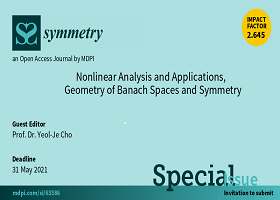- 2.2Impact Factor
- 5.3CiteScore
- 18 daysTime to First Decision
Nonlinear Analysis and Applications, Geometry of Banach Spaces and Symmetry
This special issue belongs to the section “Mathematics“.
Special Issue Information
Dear Colleagues,
Recently, fixed point theory (with topological fixed point theory, metric fixed point theory, and discrete fixed point theory), geometry of Banach spaces, and symmetry are very important and powerful tools to study nonlinear analysis and applications, especially nonlinear operator theory and applications, equilibrium problems and applications, variational inequality problems and applications, complementarity problems and applications, saddle point theory and applications, differential and integral equations and applications, optimization problems and applications, approximation theory and applications, numerical analysis and applications, the stability of functional equations, game theory and applications, programming problems and applications, engineering, topology, economics, geometry, inequality problems, and many others.
The aim of this Special Issue of Symmetry is to enhance the new development of fixed point theory, related nonlinear problems, the geometry of Banach spaces, and symmetry with applications. Our Guest Editor will accept very-high-quality papers containing original results and survey articles of exceptional merit. Due to the great success of our Special Issue "Nonlinear Analysis and Applications, Geometry of Banach Spaces and Symmetry" we decided to set up a second volume. We invite you to contribute to the Special Issue "Nonlinear Analysis and Applications, Geometry of Banach Spaces and Symmetry II" by https://www.mdpi.com/journal/symmetry/special_issues/J1V0TZBN20.
Prof. Dr. Eulalia Martínez Molada
Guest Editor
Manuscript Submission Information
Manuscripts should be submitted online at www.mdpi.com by registering and logging in to this website. Once you are registered, click here to go to the submission form. Manuscripts can be submitted until the deadline. All submissions that pass pre-check are peer-reviewed. Accepted papers will be published continuously in the journal (as soon as accepted) and will be listed together on the special issue website. Research articles, review articles as well as short communications are invited. For planned papers, a title and short abstract (about 250 words) can be sent to the Editorial Office for assessment.
Submitted manuscripts should not have been published previously, nor be under consideration for publication elsewhere (except conference proceedings papers). All manuscripts are thoroughly refereed through a single-blind peer-review process. A guide for authors and other relevant information for submission of manuscripts is available on the Instructions for Authors page. Symmetry is an international peer-reviewed open access monthly journal published by MDPI.
Please visit the Instructions for Authors page before submitting a manuscript. The Article Processing Charge (APC) for publication in this open access journal is 2400 CHF (Swiss Francs). Submitted papers should be well formatted and use good English. Authors may use MDPI's English editing service prior to publication or during author revisions.
Keywords
- fixed point theory and applications
- best proximity point theory and applications
- nonlinear operator theory and applications
- generalized contractive mappings
- equilibrium problems and applications
- variational inequality problems and applications
- optimization problems and applications
- game theory and applications
- numerical algorithms for nonlinear problems
- well-posedness in fixed point theory
- stability of functional equations related to fixed point theory
- differential and integral equations
- geometry of Banach spaces
- symmetry

Benefits of Publishing in a Special Issue
- Ease of navigation: Grouping papers by topic helps scholars navigate broad scope journals more efficiently.
- Greater discoverability: Special Issues support the reach and impact of scientific research. Articles in Special Issues are more discoverable and cited more frequently.
- Expansion of research network: Special Issues facilitate connections among authors, fostering scientific collaborations.
- External promotion: Articles in Special Issues are often promoted through the journal's social media, increasing their visibility.
- e-Book format: Special Issues with more than 10 articles can be published as dedicated e-books, ensuring wide and rapid dissemination.

